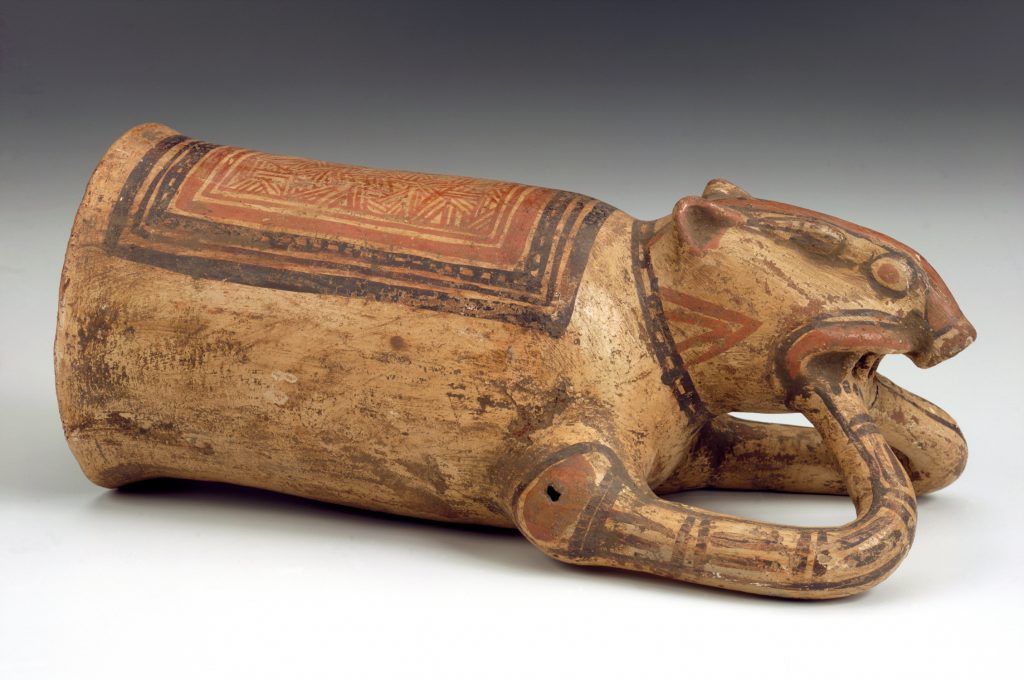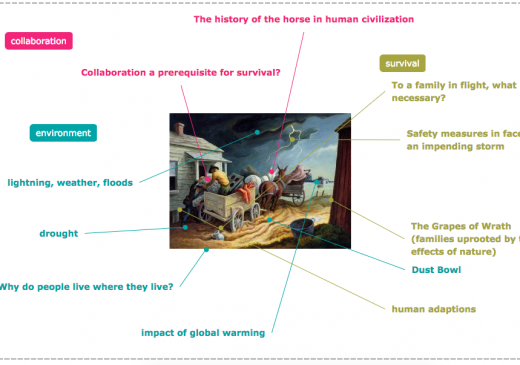Thomas Hart Benton (artist)
Thomas Hart Benton was an American regionalist painter and muralist. Early in...
view artistStudents will examine the physical properties of soil by studying works of art, testing local samples, and using soil to create their own works of art.

Peccary Effigy Jar, by Unknown Costa Rican Artist
Day 1
1. Break the class into small discussion groups. Assign each group an image of one of the three ceramic works of art. Ask the students to discuss the work as a group and make a list of the physical characteristics of the work of art (or what they see).
2. After students have a list of observable characteristics, ask the students to work as a group to write a paragraph or create a graphic organizer that describes the physical properties of clay based on their ceramic object and list of observations.
3. Have the groups present their analysis to the class.
4. During the presentations, create a class chart that lists clay’s physical properties, noting areas of variability such as color and texture.
5. Lead a discussion about natural resources. Ask students to make predictions about what natural resources were available during this time in Costa Rica and how they could be used. Questions include: What natural resources do you think were available to people living in Costa Rica at this time? (gold, clay, wood) How can artists use these materials to create works of art? Where would artists have gotten these materials during this time in Costa Rica?
6. For homework: Have students research natural resources in Costa Rica to confirm their predictions. Ask students use the Costa Rica Natural Resources Research Handout to guide their research. Students should also bring in a small (quart-size bag) sample of soil from around their home.
Day 2
7. Discuss the research students completed about Costa Rica’s resources. Share the background information about each piece of ceramic art. Discuss natural resources and how they are used for art materials. Questions include: What natural resources were available to people living in Costa Rica at this time? (gold, clay, wood) How can artists use these materials to create works of art? Where would artists have gotten these materials during this time? Why would these materials be good mediums to use to create art? What drawbacks might these materials have?
8. Discuss soil texture with the class by showing the Soil PowerPoint.
9. Have students complete the “What’s Your Soil Texture?” lab using soil samples that the students supply from around their homes. Review soil texture by doing a Texture-by-Feel analysis and by using the Soil Triangle. To use the Soil Triangle, students will create a “soil shake.” Allow these to settle overnight.
Day 3
10. Compare the results of the soil texture lab. Students will measure each layer of their “soil shake” and create a ratio of each layer of the soil’s texture compared to the entire sample. Students will then convert these into percentages and use the Soil Triangle to determine their soil’s texture. Students will complete the “What’s Your Soil Texture?” analysis and conclusion questions.
11. After students have determined the texture of each sample, label and group the local soil samples as clay, sand, and silt. Allow students to make observations of each group (sand, silt, clay) and compare and contrast the soil samples by using the Soil Texture Graphic Organizer. Students should observe physical characteristics, texture, color, and consistency. Students should use the sense of touch to observe as well as observe the soil using a hand lens.
12. As a class, discuss the properties of materials that may be appealing to an artist (malleability, color, availability). Ask students to use their comparisons of the sand, silt, and clay to evaluate each type of soil to be used for art making. Have students write a short paragraph describing which soil texture they believe would be the best to use for creating ceramic art. Students should use their analysis of the soil (from their graphic organizer) to defend their reasoning.
13. Have students compare the physical characteristics of the local samples of soil with clay purchased from an art-supply store. As a class, discuss the reasons the store-bought clay has been manufactured to accentuate particular physical properties.
Day 4
14. Project and discuss Spring on the Missouri by Thomas Hart Benton. Questions may include: What do you see in this picture? What do you think is going on? What do you see that makes you say that? What natural force is shown in this picture? How do natural forces affect the environment, humans, and other creatures? How are the people reacting to this natural phenomenon? How does the artist use texture in this painting?
15. Discuss background, middle ground, and foreground of paintings. Have students pick out the background, middle ground, and foreground on Spring on the Missouri. Ask students: How does the artist distinguish between each one? What effect does this have on the painting?
16. Using a large (11×14) piece of poster board, have students sketch a dramatic nature scene. Tell students to be sure that their drawing shows the difference between the background, middle ground, and foreground.
17. Tell students that they are going to be using materials from the earth to create a painting. Students should use the local soil samples to create a paint by mixing the soil with glue and water. (Students can create the consistency they want by using more or less water/glue mixture).
18. Students should use the paint to paint their dramatic nature scenes, taking careful consideration into painting the background, middle ground, and foreground.
19. Once students’ paintings are dry, ask students to complete the reflection handout and share reflections with the class.
Written by Jennifer Rogers, Science Teacher
Vocabulary
natural resource
effigy
peccary
shaman
sincense
texture
malleability
sand, silt, clay
soil
triangle
texture-by-feel analysis
background
middle ground
foreground
Materials
Links
Thomas Hart Benton was an American regionalist painter and muralist. Early in...
view artistby barryrbarber
view concept map